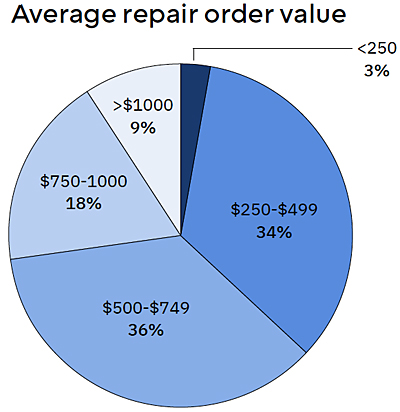05/02/2025
New national survey report offers tips on improving average repair orders
Source: aftermarket MATTERS
“The State of General Auto Repair Shops in the U.S.” report, recently released by PartsTech, provides general auto repair shops insights and benchmarks to help drive their growth in 2025. The study surveyed 752 general repair shop owners and employees, and also sought input from industry coaches.

This map illustrates the distribution of survey respondents across the nine Census Bureau divisions. Source: PartsTech
Among the subject matter covered — which includes survey participant statistics, shop staffing insights, service of EVs, and industry challenges such as the technician shortage — the study also delved into improving shop average repair orders, which is highlighted below. Download the complete report here.

The top selected gross profit on parts per month was 51-60%. According to The Institute for Automotive Business Excellence3, shops should aim for a benchmark of 58% gross profit on parts. Based on this target, more than 63% of respondents would benefit from reevaluating and updating their parts markup strategies to increase monthly profits.

PartsTech partnered with The Institute for Automotive Business Excellence to create a Parts Markup Guide (see chart below) featuring a detailed benchmark matrix, actionable tips to help shops create and/or optimize their strategy.
“Improper parts markup can cost shops $40,000 to $70,000 in missed profits annually,” states Cecil Bullard, owner and CEO, The Institute for Automotive Business Excellence, in the report. “When we first begin coaching a shop, we often see margins between 32% and 44%, but a proper markup matrix can improve these to 55%–58%. Fixing your parts pricing is one of the easiest ways to boost profitability.
“Create a strong matrix, train your team to use it, stick to it, and exercise discipline to avoid emotional discounting. Implementing and sticking to a strategic parts matrix leads to immediate improvements in your shop’s performance.”
Average repair order value
Thirty-six percent of respondents reported an average repair order value (ARO) between $500 and $749, with $250 to $499 in a close second.

Increasing average repair order value
Dave Kusa, Shop Coach, The Automotive Coaching and Training (ACT) Group, advised in the study, “Our clients expect us to inform them of any and all needed repairs and services their vehicles need. Sometimes, I think there is a stigma around upselling, but it is our moral and ethical duty to provide honest and detailed information about the state of the vehicle and both necessary and critical services so that the client can make the correct decision on the future of their vehicle.
“It is vitally important to completely inspect each vehicle that enters your shop thoroughly and communicate your complete findings clearly to your customers. This greatly aids in upselling and cross-selling conversations.”
Respondents were asked to indicate all actions that positively impact their average repair order
value.

Estimate approval via SMS/email
Tekmetric data from 2024 shows that Repair Orders (ROs) authorized digitally have an average value 50% higher than those without digital authorization. By allowing customers to remotely view their estimates from anywhere by sending them via SMS and email, shops empower customers with transparency and control over their repair decisions.
“Consider implementing digital estimate authorizations — they are a simple yet impactful way for your shop to build trust, deliver a seamless experience, and strengthen customer relationships,” stated Sunil Patel, Founder and CEO, Tekmetric.
Digital vehicle inspections
Perform detailed DVIs for every vehicle. Shop goals should be to include images, videos, and notes to build trust with customers and improve their understanding of what needs to be done on their vehicle. This not only leads to higher AROs but also protects shops by documenting the state of the vehicle when in a shop’s care.
“Adding thorough digital vehicle inspections (DVIs) to your workflow can quickly boost ARO with longtime customers and make a great first impression on new customers,” stated Jonathan Moretti, Enterprise Solutions Engineer, Shopmonkey. “DVIs help your customers clearly see what’s happening with their vehicle — making them more confident in approving recommended services. In my role traveling across North America, I see DVIs as a top focus for successful shops — one even tracks ‘completed inspections’ as their top KPI.”
